Related Research Articles
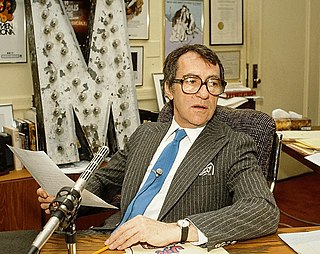
Joseph Papp was an American theatrical producer and director. He established The Public Theater in what had been the Astor Library Building in Lower Manhattan. There Papp created a year-round producing home to focus on new plays and musicals. Among numerous examples of these were the works of David Rabe, Ntozake Shange's For Colored Girls Who Have Considered Suicide When the Rainbow Is Enuf, Charles Gordone's No Place to Be Somebody, and Papp's production of Michael Bennett's Pulitzer Prize–winning musical A Chorus Line. Papp also founded Shakespeare in the Park, helped to develop other off-Broadway theatres and worked to preserve the historic Broadway Theatre District.

In American theater, summer stock theater is a theater that presents stage productions only in the summer. The name combines the season with the tradition of staging shows by a resident company, reusing stock scenery and costumes. Summer stock theaters frequently take advantage of seasonal weather by having their productions outdoors, under tents set up temporarily for their use, or in barns.
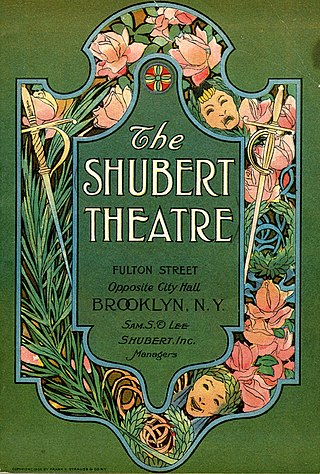
The Shubert Organization is a theatrical producing organization and a major owner of theatres based in Manhattan, New York City. It was founded by the three Shubert brothers — Lee, Sam, and Jacob J. Shubert — in the late 19th century. They steadily expanded, owning many theaters in New York and across the United States. Since then it has gone through changes of ownership, but it is still a major theater chain.

The Upright Citizens Brigade Theatre is an American improvisational and sketch comedy training center and theatre, originally founded by Upright Citizens Brigade troupe members Matt Besser, Amy Poehler, Ian Roberts and Matt Walsh.
Landmark Theatres is a movie theatre chain founded in 1974 in the United States. It was formerly dedicated to exhibiting and marketing independent and foreign films. Landmark consists of 34 theatres with 176 screens in 24 markets. It is known for both its historic and newer, more modern theatres. Helmed by its President, Kevin Holloway, Landmark Theatres is part of Cohen Media Group.

The Lyric Theatre is a Broadway theater at 214 West 43rd Street in the Theater District of Midtown Manhattan in New York City. Opened in 1998, the theater was designed by Richard Lewis Blinder of Beyer Blinder Belle, in collaboration with Peter Kofman, for Garth Drabinsky and his company Livent. The Lyric Theatre was built using parts of two former theaters on the site: the Apollo Theatre, built in 1920 to a design by Eugene De Rosa, and the old Lyric Theatre, built in 1903 to a design by Victor Hugo Koehler. The theater contains 1,622 seats across three levels and is operated by ATG Entertainment. The theater building is owned by the city and state governments of New York and was developed by New 42nd Street.

The Todd Haimes Theatre is a Broadway theater at 227 West 42nd Street in the Theater District of Midtown Manhattan in New York City. Built in 1918, it was designed by George Keister and developed by brothers Edgar and Archibald Selwyn, for whom the theater was originally named. The theater is owned by the city and state governments of New York and leased to New 42nd Street. It has 740 seats across two levels and is operated by Roundabout Theatre Company.
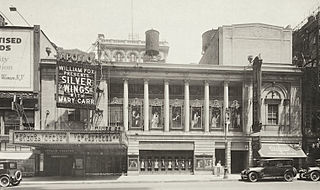
The Times Square Theater is a former Broadway and movie theater at 215–217 West 42nd Street in the Theater District of Midtown Manhattan in New York City, near Times Square. Built in 1920, it was designed by Eugene De Rosa and developed by brothers Edgar and Archibald Selwyn. The building, which is no longer an active theater, is owned by the city and state governments of New York and leased to New 42nd Street.
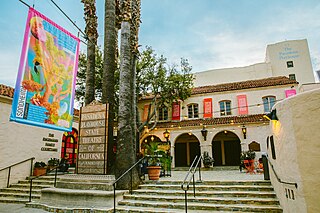
Pasadena Playhouse is a Tony Award-winning historic performing arts venue located 39 S. El Molino Avenue in Pasadena, California. The 686-seat auditorium produces a variety of cultural and artistic events, professional shows, and community engagements each year.
Mark Saltzman is an American script writer who has written films, plays and musicals and for TV. He worked for several years for Sesame Street. He has been given seven Emmy Awards for Best Writing for a Children's Show.

Ford Theatre, spelled Ford Theater for the original radio version and known, in full, as The Ford Television Theatre for the TV version, is a radio and television anthology series broadcast in the United States in the 1940s and 1950s. At various times the television series appeared on all three major television networks, while the radio version was broadcast on two separate networks and on two separate coasts. Ford Theatre was named for its sponsor, the Ford Motor Company, which had an earlier success with its concert music series, The Ford Sunday Evening Hour (1934–42).
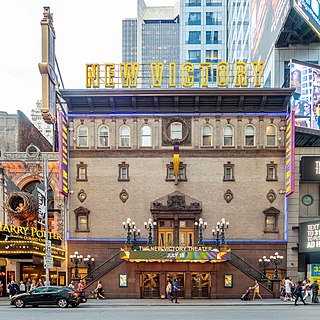
The New Victory Theater is a theater at 209 West 42nd Street in the Theater District of Midtown Manhattan in New York City, near Times Square. Built in 1900 as the Republic Theatre, it was designed by Albert Westover and developed by Oscar Hammerstein I as a Broadway theater. The theater has been known by several names over the years, including the Belasco Theatre, Minsky's Burlesque, and the Victory Theatre. The theater is owned by the city and state governments of New York and leased to nonprofit New 42, which has operated the venue as a children's theater since 1995. The New Victory presents theater shows, dance shows, puppet shows, and other types of performance art shows from all around the world.

Canberra Theatre Centre (CTC), also known as the Canberra Theatre, is the Australian Capital Territory’s central performing arts venue and Australia's first performing arts centre, the first Australian Government initiated performing arts centre to be completed. It opened on 24 June 1965 with a gala performance by the Australian Ballet.

The Charles Playhouse is a theater at 74 Warrenton Street Boston in the Boston Theater District. The venue comprises an approximately 500-seat mainstage, which hosts the long-running Blue Man Group, and a 200-seat second stage that hosted Shear Madness until March 2020.

The Gramercy Theatre is a music venue in New York City. It is located in the Gramercy neighborhood of Manhattan, on 127 East 23rd Street. Built in 1937 as the Gramercy Park Theatre, it is owned and operated by Live Nation as one of their two concert halls in New York City, the other being the nearby Irving Plaza.

The Liberty Theatre is a former Broadway theater at 234 West 42nd Street in the Theater District of Midtown Manhattan in New York City. Opened in 1904, the theater was designed by Herts & Tallant and built for Klaw and Erlanger, the partnership of theatrical producers Marc Klaw and A. L. Erlanger. The theater has been used as an event venue since 2011 and is part of an entertainment and retail complex developed by Forest City Ratner. The theater is owned by the city and state governments of New York and leased to New 42nd Street. Brookfield Asset Management, which acquired Forest City in 2018, subleases the venue from New 42nd Street.

Shubert Alley is a pedestrian alley in the Theater District of Midtown Manhattan in New York City. The alley, a privately owned public space, connects 44th and 45th Streets and covers about 6,400 square feet (590 m2). It runs through the middle of a city block, parallel to Eighth Avenue to the west and Broadway to the east. The western half of the alley abuts the Shubert and Booth theaters, while the eastern half is adjacent to One Astor Plaza. Because it is near several major theaters, the alley has been considered the geographical center of Broadway theatre.

The Provincetown Playhouse is a historic theatre at 133 MacDougal Street between West 3rd and 4th streets in the Greenwich Village neighborhood of Manhattan in New York City. It is named for the Provincetown Players, who converted the former stable and wine-bottling plant into a theater in 1918.

Village East by Angelika is a movie theater at 189 Second Avenue, on the corner with 12th Street, in the East Village of Manhattan in New York City. Part of the former Yiddish Theatre District, the theater was designed in the Moorish Revival style by Harrison Wiseman and built from 1925 to 1926 by Louis Jaffe. In addition to Yiddish theatre, the theater has hosted off-Broadway shows, burlesque, and movies. Since 1991, it has been operated by Angelika Film Center as a seven-screen multiplex. Both the exterior and interior of the theater are New York City designated landmarks, and the theater is on the National Register of Historic Places.

The 55th Street Playhouse—periodically referred to as the 55th Street Cinema and Europa Theatre—was a 253-seat movie house at 154 West 55th Street, Midtown Manhattan, New York City, that opened on May 20, 1927. Many classic art and foreign-language films, including those by Jean Cocteau, Sergei Eisenstein, Federico Fellini, Abel Gance, Fritz Lang, Josef Von Sternberg and Orson Welles, were featured at the theater. Later, Andy Warhol presented many of his notable films in this building in the late 1960s. Other notable films were also shown at the theater, including Boys in the Sand (1971) and Him (1974).
References
- ↑ Lynch, Scott (December 6, 2021). "Great Tavern-Style Pizza And Other Midwest Favorites Now Being Served In The West Village" . Retrieved June 30, 2022.
- ↑ Arthur, Heidi; Misshula, Nancy E.; Pollock, Jane (March 15, 1998). Who Knew Raising Kids in New York Could Be This Easy?: From Playgrounds to Preschools, Strollers to Sneakers, Eateries to Excursions-- Everything a Manhattan Parent Needs to Know. Macmillan. ISBN 978-0-312-18222-9.
- 1 2 3 Kilgannon, Corey (January 24, 1999). "MAKING IT WORK; Serial Drama at the Grove Street Playhouse". The New York Times. ISSN 0362-4331 . Retrieved June 30, 2022.
- ↑ "Grove Street Playhouse". TheaterMania. Retrieved June 30, 2022.
- ↑ "The Courtyard Playhouse, New York, NY - AboutTheArtists Theatre Profile". www.abouttheartists.com. Retrieved June 30, 2022.
- ↑ Smith, C. S. (October 13, 2014). The New York Times Theater Reviews 1997-1998. Routledge. p. 227. ISBN 978-1-136-75033-5.